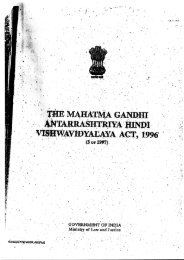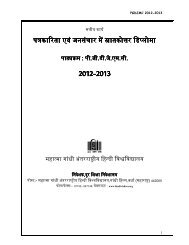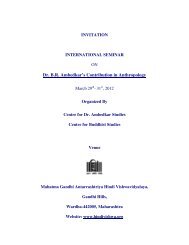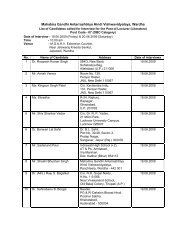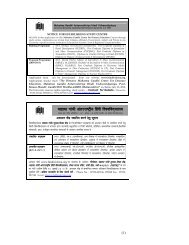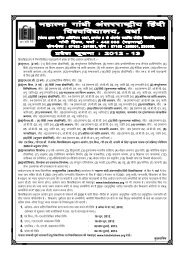Mamta Kalia
Mamta Kalia
Mamta Kalia
Create successful ePaper yourself
Turn your PDF publications into a flip-book with our unique Google optimized e-Paper software.
nuanced reading of the strategy of veiling:<br />
…veiling as a social practice is not fixed<br />
or unidirectional; instead, it is a dynamic<br />
practice in which both men and women<br />
are implicated. In addition, there is a dialectical<br />
relationship between veiling and unveiling:<br />
that which covers is capable also of<br />
uncovering. In practice women have a great<br />
deal of latitude in how they present themselves<br />
to the gaze of male onlookers, involving<br />
body language, eye contact, types of veil<br />
worn, clothing worn under the veil, and<br />
the manner in which the veil itself is opened<br />
Notes and References:<br />
136 :: April-June 2010<br />
and closed at strategic moments to lure<br />
or mask, to reveal or conceal the face,<br />
the body or the clothing underneath. 22<br />
A creative reappraisal of gendering<br />
the look in Iranian cinema therefore<br />
assumes critical importance. Especially,<br />
when the success of Iranian films<br />
internationally has helped restore pride<br />
among the Iranian people in their culture<br />
and heritage and when Iran stands<br />
demonized as a terrorist nation in the<br />
international media.<br />
1. To a great extent watching films is about looking at and identifying with the<br />
screen image. There are three different ways in which the look is organized<br />
– (a) characters inside the diegesis looking at each other (b) the diegetic audience<br />
looking at the characters of the film and (c) the audience inside the cinema<br />
theatres looking both at the characters and the diegetic audience.<br />
2. I began watching Iranian films in International Film Festivals in India 1998<br />
onwards. But then I did not ask questions about their contexts of production<br />
or their channels of circulation and reception worldwide. At the same time<br />
I realized that there was a need to differentiate between Iranian cinema seen<br />
in the film festivals from the Farsi cinema, which is similar in many respects<br />
to mainstream Hindi cinema or Bollywood in form. Since 2001, the popular<br />
Indian television channel Eenadu TV (Urdu) has been occasionally screening<br />
Farsi films dubbed in Hindi. Also UTV World Movies and NDTV Lumiere, routinely<br />
offer contemporary Iranian films (with English subtitles) to its discerning audiences.<br />
3. Hamid Reza Sadr, Iranian Cinema, A Political History, I.B.Tauris, London, 2006,<br />
p.66.<br />
4. Ibid, p.77.<br />
5. Ibid, p.78.<br />
6. Ibid, p.82.<br />
7. Houshang Golmakani, Stars Within Reach, in Aruna Vasudev, Latika Padgaonkar<br />
and Rashmi Doraiswamy (ed.), Being and Becoming, The Cinemas of Asia, Macmillan,<br />
New Delhi, 2002, p. 191.<br />
8. Azarmi Dukht Safawi and A.W.Azhar Dehlvi, Revolution and Creativity, A Survey<br />
of Iranian Literature, Films and Art in the Post revolutionary Era, Rupa & Company,<br />
New Delhi, 2006, p.189.




